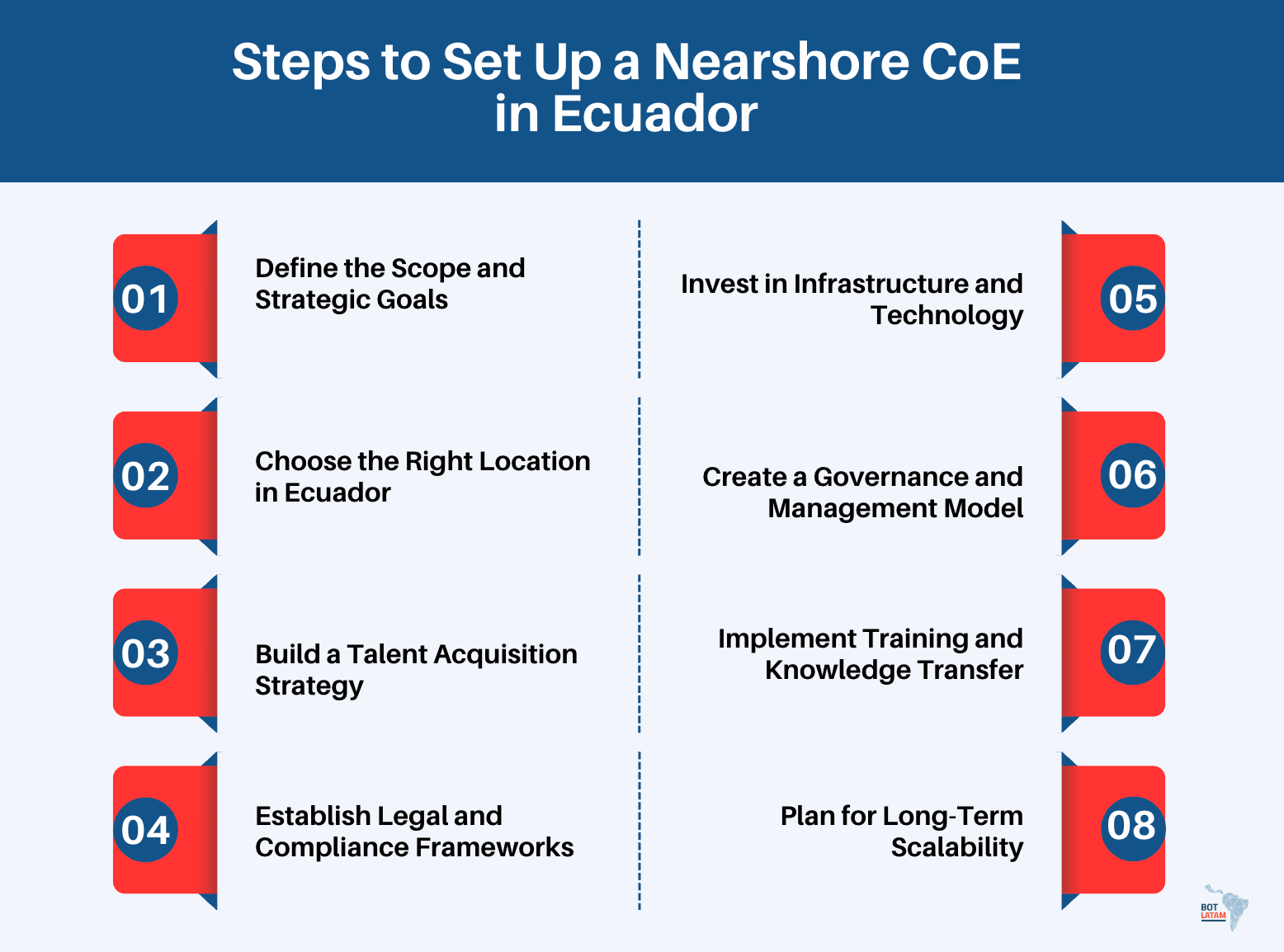Setting up a Nearshore Center of Excellence (CoE) in Ecuador is becoming a strategic move for companies that want to scale efficiently while keeping control over quality and operations. With its skilled workforce, competitive costs, and proximity to the US, Ecuador is positioning itself as a serious player in the LATAM CoE landscape.
The nearshore model isn’t just about saving money. It’s about access to top talent, alignment with US time zones, and building a sustainable hub for innovation. According to the Inter-American Development Bank, Latin America will need 1.2 million more tech professionals by 2025, making now the right time to secure talent and establish a presence in growing ecosystems like Ecuador.
In this article, you’ll learn what a Nearshore CoE is, why Ecuador stands out, the step-by-step process to set one up, and how to leverage the BOT model for a smoother transition. You’ll also see potential challenges, best practices for long-term success, and where the future of nearshore development in LATAM is heading.
What Is a Nearshore Center of Excellence (CoE)?
A Nearshore Center of Excellence (CoE) is a dedicated unit designed to centralize expertise, processes, and resources in a specific business or technology domain. Unlike a regular outsourcing arrangement, a CoE acts as a strategic hub where specialized teams drive innovation, maintain quality standards, and continuously improve performance.
The “nearshore” part means that the center operates in a country geographically close to your main market. For US-based companies, that often means Latin America. This proximity allows smoother collaboration, shared time zones, and cultural alignment, making it easier to manage complex projects without the friction that can come with offshore setups in Asia or Eastern Europe.
Why Companies Build Nearshore CoEs
Businesses turn to nearshore CoEs when they need more than cost savings. These centers are built to establish operational consistency, scale high-value capabilities, and reduce dependency on scattered teams.
For example, a CoE focused on software engineering in Ecuador might standardize agile practices, introduce automation frameworks, and build reusable code libraries that benefit multiple projects. This creates both efficiency and competitive advantage.
Nearshore CoE vs. Traditional Outsourcing
A Nearshore CoE differs significantly from a traditional outsourcing arrangement. In outsourcing, you usually contract a vendor for short-term tasks or projects, often with limited knowledge retention inside your organization.
With a CoE, the focus shifts toward building long-term expertise that stays within your extended team. You keep control over intellectual property, operational standards, and training investments. This is why many companies view nearshore CoEs as an extension of their enterprise rather than just an outsourced service.
The Role of LATAM in Nearshore CoEs
Latin America has become a prime location for nearshore centers of excellence. Stronger IT ecosystems, large pools of bilingual professionals, and government support for tech industries make it attractive. IDC projects that IT services spending in Latin America will surpass $83 billion by 2026, showing clear momentum for businesses to establish sustainable nearshore hubs.
Ecuador in particular, is gaining attention for its blend of affordability, skilled engineers, and strategic location, making it an emerging choice for companies looking to establish a scalable CoE close to home.
Why Ecuador Is Emerging as a Nearshore Center of Excellence
Ecuador is gaining momentum as a nearshore Center of Excellence (CoE) destination because of its unique mix of talent availability, economic stability, and geographic advantages. While larger markets in LATAM like Brazil, or Colombia often dominate headlines, Ecuador is quietly building an environment that supports advanced business operations.
1. Strategic Location and Time Zone Alignment:
Ecuador’s location makes it highly attractive for US companies. The country shares similar time zones with major US cities, which simplifies communication and accelerates collaboration. For businesses used to dealing with offshore time gaps of 8 to 12 hours, working with Ecuador means teams can operate in real time without late-night calls or delayed decision-making.
2. Skilled Talent Pool and Growing Education System:
Ecuador is investing heavily in education and workforce development. According to UNESCO, over 70% of Ecuadorian students completing tertiary education pursue fields related to engineering, IT, and applied sciences. Universities in Quito, Cuenca, and Guayaquil are producing graduates with strong technical skills, many of whom are bilingual.
This growing talent base allows companies to build specialized CoEs in Ecuador in areas like cloud services, data analytics, and software engineering without facing the intense competition for talent seen in larger LATAM hubs.
3. Competitive Cost Structure:
Cost efficiency is another reason Ecuador stands out. Labor costs for skilled IT professionals in Ecuador are 30–40% lower than in Chile, according to the Inter-American Development Bank. This creates a significant advantage for businesses that want to establish a CoE with sustainable overhead while maintaining high-quality standards.
The lower cost of living and favorable operating expenses also mean that long-term investments in infrastructure, training, and retention strategies are more feasible compared to pricier nearshore alternatives.
4. Supportive Business and Technology Ecosystem:
Ecuador’s government has rolled out incentives to attract foreign investment in the technology sector. Programs like the Ecuador Digital 2025 agenda are designed to expand digital transformation, improve connectivity, and encourage partnerships between international companies and local institutions.
The World Bank’s Doing Business Report highlights ongoing regulatory improvements, especially around starting a business and accessing credit, making it easier for foreign firms to establish structured CoEs in Ecuador.
5. Rising Role in the LATAM Nearshore CoE Landscape:
While still considered an emerging market, Ecuador is positioning itself as a niche hub for nearshore centers of excellence within LATAM. Its combination of affordability, bilingual technical talent, and proximity to North America makes it a realistic option for organizations that want flexibility without sacrificing capability.
As global demand for tech services grows, Latin America’s IT services market is forecasted to hit $83 billion by 2026, according to IDC. Ecuador’s role as a competitive nearshore CoE location will continue to expand.
Steps to Set Up a Nearshore CoE in Ecuador

1. Define the Scope and Strategic Goals:
The first step is clarifying what functions your Nearshore CoE in Ecuador will handle. Decide whether the center will focus on software development, data analytics, customer support, or a combination. Align the scope with your overall business strategy.
2. Choose the Right Location in Ecuador:
Cities like Quito, Guayaquil, and Cuenca each offer distinct advantages. Quito is strong in tech education, Guayaquil has better logistics and connectivity, while Cuenca is known for affordability and talent retention. Selecting the right city should depend on your industry focus, talent needs, and access to infrastructure.
3. Build a Talent Acquisition Strategy:
Recruitment is central to a successful Ecuador Center of Excellence. Focus on bilingual professionals and graduates with backgrounds in engineering and applied sciences. Ecuador produces thousands of STEM graduates annually, and UNESCO data shows over 70% of students in higher education study science or technical fields. Partnering with local universities and training institutes can help secure top talent before competitors do.
4. Establish Legal and Compliance Frameworks:
Ecuador has specific labor laws, tax regulations, and corporate requirements that must be addressed before operations begin. Registering the entity, setting up payroll, and ensuring compliance with data protection rules are essential. The World Bank notes that Ecuador has made consistent improvements in business regulation, but navigating these processes still requires careful planning.
5. Invest in Infrastructure and Technology:
A nearshore CoE in Ecuador needs reliable infrastructure. Ensure access to modern office spaces, secure networks, and high-speed internet. Ecuador has invested heavily in expanding broadband, with internet penetration reaching 81% of the population in 2023, according to the International Telecommunication Union. Cloud platforms, collaboration tools, and cybersecurity protocols should be implemented early to avoid disruptions.
6. Create a Governance and Management Model:
Effective governance prevents the CoE from becoming siloed. Define reporting structures, KPIs, and accountability mechanisms. McKinsey research shows that businesses with structured governance models in their CoEs see 20–30% higher productivity compared to ad hoc setups. Clear leadership roles help maintain alignment with corporate objectives.
7. Implement Training and Knowledge Transfer:
Continuous learning keeps the CoE competitive. Establish training programs, mentorship initiatives, and knowledge-sharing frameworks. Ecuador’s growing digital workforce benefits from partnerships with global edtech platforms, making it easier to upskill teams in areas like AI, cloud, and DevOps. This ensures your CoE remains relevant as technologies evolve.
8. Plan for Long-Term Scalability:
A nearshore CoE should be built with expansion in mind. Start with a core team, then scale gradually as processes stabilize. Include retention strategies to reduce turnover, since LinkedIn’s Global Talent Trends report highlights that companies with strong learning and development programs retain employees 53% longer. Scalability planning ensures your CoE grows without sacrificing efficiency.
Leveraging the BOT Model for an Ecuadorian CoE
Understanding the BOT Model.
The Build-Operate-Transfer (BOT) model is a structured approach to establishing a Center of Excellence in Ecuador. In this framework, a local partner sets up and manages the CoE during the initial phase. Once operations stabilize, ownership and management responsibilities are transferred to your organization.
This model is commonly used in nearshore operations because it reduces entry risks while ensuring you retain long-term control. Gartner notes that BOT arrangements can cut the time to full operational ownership by up to 40% compared to building independently.
Build Phase: Setting Up the Foundation.
In the build stage, the focus is on establishing infrastructure, hiring staff, and defining processes. Local experts handle legal registration, compliance, and recruitment in Ecuador, ensuring the CoE is set up according to regulations. This stage usually lasts between 12 and 24 months, depending on the size and complexity of the operation.
Operate Phase: Optimizing Performance.
During the operate phase, the CoE runs under the management of the partner organization. Daily operations, performance monitoring, and process refinement are handled externally while knowledge transfer begins. Deloitte research shows that organizations using BOT models report 25% higher operational efficiency during the operate stage compared to traditional outsourcing setups.
Transfer Phase: Taking Full Control.
The final stage is the transfer of ownership. At this point, your organization assumes complete control over the Ecuador CoE, including staff, assets, and processes. The transition is typically gradual, allowing your internal leadership to adapt while minimizing disruptions. A phased transfer reduces the risk of knowledge loss and ensures teams are fully aligned with enterprise goals.
Why Ecuador Works Well with BOT.
Ecuador’s emerging tech ecosystem, bilingual workforce, and competitive costs align well with the BOT approach. Local expertise helps bridge regulatory and cultural gaps, while your organization benefits from long-term ownership.
Ready to Set Up a Nearshore CoE in Ecuador?
Building a Nearshore Center of Excellence in Ecuador is no longer a future trend; it’s a practical strategy for companies seeking scalability, operational efficiency, and access to specialized talent.
At BOT LATAM, we help businesses reduce entry risks and accelerate growth through the Build-Operate-Transfer model, guiding every step from setup to ownership. Our experience across multiple LATAM markets allows us to design CoEs in LATAM that are compliant, efficient, and scalable, while ensuring smooth knowledge transfer for long-term sustainability. Ready to build your own? Contact us to start now!

Revolutionize Your Workflow with Our Innovative BOT Strategy!
Enhance your operations seamlessly and adapt to market demands
Contact Us

.jpg)


%2017.26.38.png)